Evaluation of Wind Flow Characteristics by RANS-Based Numerical Site Calibration (NSC) Method with Met-Tower Measurements and Its Application to a Complex Terrain
Abstract
1. Introduction
2. Numerical Analysis Method
2.1. Numerical Site Calibration (NSC) Method
2.2. Governing Equation and Turbulence Flow Model
3. Site Information and Boundary Conditions for Numerical Analysis
3.1. Wind Turbine Sites
3.2. Boundary Conditions
3.3. Grid Sensitivity Study
4. Numerical Results
4.1. Methil, Scotland
4.2. Haenam, South Korea
5. Discussion
- Steeper hills in Methil significantly affect the wind flow at the measurement height of the wind turbine and the meteorological tower. Based on CFD analysis results, if the installation altitude of the meteorological tower is lower (6 m) than the original altitude (21.5 m), costly site calibration measurements can be avoided.
- The topography-induced wind profile and the turbulence intensity over local-scale complex terrains such as valleys and hills are dominated by separation flows in Haenam. With the proposed numerical method, the risks to turbine performance and durability could be significantly avoided by assessing the wind characteristics of the wind turbine installation site.
- The proposed numerical site calibration method based on three-dimensional RANS simulation is very useful for evaluating wind flows at prospective wind turbine installation sites over complex terrains and could be utilized for optimizing the layout of a wind turbine array.
Author Contributions
Funding
Acknowledgments
Conflicts of Interest
References
- Betz, A. Introduction to the Theory of Flow Machines; Randall, D.G., Translator; Pergamon Press: Oxford, UK, 1966. [Google Scholar]
- Mirghaed, M.R.; Roshandel, R. Site specific optimization of wind turbines energy cost: Iterative approach. Energy Convers. Manag. 2013, 73, 167–175. [Google Scholar] [CrossRef]
- Song, D.; Liu, J.; Yang, J.; Su, M.; Yang, S.; Yang, X.; Joo, Y.H. Multi-objective energy-cost design optimization for the variable-speed wind turbine at high-altitude sites. Energy Convers. Manag. 2019, 196, 513–524. [Google Scholar] [CrossRef]
- Jung, C.; Schindler, D.; Grau, L. Achieving Germany’s wind energy expansion target with an improved wind turbine siting approach. Energy Convers. Manag. 2018, 173, 383–398. [Google Scholar] [CrossRef]
- Ainslie, J.F. Calculating the flowfield in the wake of wind turbines. J. Wind Eng. Ind. Aerodyn. 1988, 27, 213–224. [Google Scholar] [CrossRef]
- Vermeer, L.J.; Sørensen, J.N.; Crespo, A. Wind turbine wake aerodynamics. Prog. Aerosp. Sci. 2003, 39, 467–510. [Google Scholar] [CrossRef]
- Sanderse, B.; Pijl, S.P.; Koren, B. Review of computational fluid dynamics for wind turbine wake aerodynamics. Wind Energy 2011, 14, 799–819. [Google Scholar] [CrossRef]
- Chamorro, L.; Porté-Agel, F. Turbulent Flow Inside and Above a Wind Farm: A Wind-Tunnel Study. Energies 2011, 4, 1916–1936. [Google Scholar] [CrossRef]
- Schümann, H.; Pierella, F.; Sætran, L. Experimental Investigation of Wind Turbine Wakes in the Wind Tunnel. Energy Procedia 2013, 35, 285–296. [Google Scholar] [CrossRef]
- Gaumond, M.; Réthoré, P.E.; Bechmann, A.; Ott, S.; Larsen, G.C.; Diaz, A.P.; Hansen, K.S. Benchmarking of Wind Turbine Wake Models in Large Offshore Windfarms; DTU: Lyngby, Denmark, 2012. [Google Scholar]
- Barthelmie, R.J.; Folkerts, L.; Ormel, F.T.; Sanderhoff, P.; Eecen, P.J.; Stobbe, O.; Nielsen, N.M. Offshore Wind Turbine Wakes Measured by Sodar. J. Atmos. Ocean. Technol. 2003, 20, 466–477. [Google Scholar] [CrossRef]
- Barthelmie, R.; Pryor, S. Impact of local meteorology on wake characteristics at Perdigão. J. Phys. Conf. Ser. 2019, 1256, 012007. [Google Scholar] [CrossRef]
- Barthelmie, R.J.; Pryor, S.C.; Wildmann, N.; Menke, R. Wind turbine wake characterization in complex terrain via integrated Doppler lidar data from the Perdigão experiment. J. Phys. Conf. Ser. 2018, 1037, 052022. [Google Scholar] [CrossRef]
- Husien, W.; El-Osta, W.; Dekam, E. Effect of the wake behind wind rotor on optimum energy output of wind farms. Renew. Energy 2013, 49, 128–132. [Google Scholar] [CrossRef]
- Jadhav, H.T.; Roy, R. Effect of turbine wake on optimal generation schedule and transmission losses in wind integrated power system. Sustain. Energy Technol. Assess. 2014, 7, 123–135. [Google Scholar] [CrossRef]
- Thomsen, K.; Sørensen, P. Fatigue loads for wind turbines operating in wakes. J. Wind Eng. Ind. Aerodyn. 1999, 80, 121–136. [Google Scholar] [CrossRef]
- Kim, S.H.; Shin, H.K.; Joo, Y.C.; Kim, K.H. A study of the wake effects on the wind characteristics and fatigue loads for the turbines in a wind farm. Renew. Energy 2015, 74, 536–543. [Google Scholar] [CrossRef]
- Fischer, A.; Bespalov, V.; Udina, N.; Samarskaya, N.; Sucameli, C.R.; Bortolotti, P.; Croce, A. Prediction and reduction of noise from a 2.3 MW wind turbine. J. Phys. Conf. Ser. 2007, 75, 012083. [Google Scholar]
- Björkman, M. Long time measurements of noise from wind turbines. J. Sound Vib. 2004, 277, 567–572. [Google Scholar] [CrossRef]
- Fredianelli, L.; Stefano, C.; Gaetano, L. A procedure for deriving wind turbine noise limits by taking into account annoyance. Sci. Total Environ. 2019, 648, 728–736. [Google Scholar] [CrossRef]
- Doolan, C.J.; Moreau, D.J.; Brooks, L.A. Brooks. Wind Turbine Noise Mechanisms and Some Concepts for Its Control. Acoust. Aust. 2012, 40, 7–13. [Google Scholar]
- Muzet, A. Environmental noise, sleep and health. Sleep Med. Rev. 2007, 11, 135–142. [Google Scholar] [CrossRef]
- Zacarías, F.F.; Molina, R.H.; Ancela, J.L.C.; López, S.L.; Ojembarrena, A.A. Noise exposure in preterm infants treated with respiratory support using neonatal helmets. Acta Acust. United Acust. 2013, 99, 590–597. [Google Scholar] [CrossRef]
- Minichilli, F.; Gorini, F.; Ascari, E.; Bianchi, F.; Coi, A.; Fredianelli, L.; Licitra, G.; Manzoli, F.; Mezzasalma, L.; Cori, L. Annoyance judgment and measurements of environmental noise: A focus on Italian secondary schools. Int. J. Environ. Res. Public Health 2018, 15, 208. [Google Scholar] [CrossRef] [PubMed]
- Dratva, J.; Phuleria, H.C.; Foraster, M.; Gaspoz, J.M.; Keidel, D.; Künzli, N.; Liu, L.J.; Pons, M.; Zemp, E.; Gerbase, M.W.; et al. Transportation noise and blood pressure in a population-based sample of adults. Environ. Health Perspect. 2012, 120, 50–55. [Google Scholar] [CrossRef] [PubMed]
- Miedema, H.M.E.; Oudshoorn, C.G.M. Annoyance from transportation noise: Relationships with exposure metrics DNL and DENL and their confidence intervals. Environ. Health Perspect. 2001, 109, 409–416. [Google Scholar] [CrossRef] [PubMed]
- Gallo, P.; Fredianelli, L.; Palazzuoli, D.; Licitra, G.; Fidecaro, F. A procedure for the assessment of wind turbine noise. Appl. Acoust. 2016, 114, 213–217. [Google Scholar] [CrossRef]
- International Electrotechnical Commission. IEC 61400-12-1, Part 12-1: Power Performance Measurements of Electricity Producing Wind Turbines; IEC: Geneva, Switzerland, 2005. [Google Scholar]
- Sanada, T. Numerical Site Calibration on a Complex Terrain and its Application for Wind Turbine Performance Measurements. In Proceedings of the European Wind Energy Conference, Athens, Greece, 27 February–2 March 2006; pp. 1187–1194. [Google Scholar]
- Brodeur, P.; Masson, C. Numerical Site Calibration over Complex Terrain. J. Sol. Energy Eng. 2008, 130. [Google Scholar] [CrossRef]
- Miyagawa, K.; Kanazawa, S.; IIDA, M.; Arakawa, C. Application in the size of computational domain of NSC using MSSG-A. Jpn. Wind Energy Assoc. 2008, 30, 117–120. [Google Scholar]
- Yan, B.W.; Li, Q.S. Coupled on-site measurement/CFD based approach for high-resolution wind resource assessment over complex terrains. Energy Convers. Manag. 2016, 117, 351–366. [Google Scholar] [CrossRef]
- Ansys, Inc. ANSYS CFX-Solver Theory Guide; ANSYS CFX Release 15; ANSYS: Canonsburg, PA, USA, 2013. [Google Scholar]
- Schulz, C.; Klein, L.; Weihing, P.; Lutz, T.; Krämer, E. CFD Studies on Wind Turbines in Complex Terrain under Atmospheric Inflow Conditions. J. Phys. Conf. Ser. 2014, 524, 012134. [Google Scholar] [CrossRef]
- Schulz, C.; Klein, L.; Weihing, P.; Lutz, T. Investigations into the Interaction of a Wind Turbine with Atmospheric Turbulence in Complex Terrain. J. Phys. Conf. Ser. 2016, 753, 032016. [Google Scholar] [CrossRef]
- Tabib, M.; Rasheed, A.; Kvamsdal, T. LES and RANS simulation of onshore Bessaker wind farm: Analyzing terrain and wake effects on wind farm performance. J. Phys. Conf. Ser. 2015, 625, 012032. [Google Scholar] [CrossRef]
- Castellani, F.; Astolfi, D.; Mana, M.; Piccioni, E.; Becchetti, B.; Terzi, L. Investigation of terrain and wake effects on the performance of wind farms in complex terrain using numerical and experimental data. Wind Energy 2017, 20, 1277–1289. [Google Scholar]
- Van der Laan, M.P.; Sørensen, N.N.; Réthoré, P.E.; Mann, J.; Kelly, M.C.; Troldborg, N. The k-ε- fP model applied to double wind turbine wakes using different actuator disk force methods. Wind Energy 2015, 18, 2223–2240. [Google Scholar] [CrossRef]
- Sessarego, M.; Shen, W.Z.; van der Laan, M.P.; Hansen, K.S.; Zhu, W.J. CFD Simulations of Flows in a Wind Farm in Complex Terrain and Comparisons to Measurements. Appl. Sci. 2018, 8, 788. [Google Scholar] [CrossRef]
- Rodi, W. Comparison of LES and RANS calculations of the flow around bluff bodies. J. Wind Eng. Ind. Aerodyn. 1997, 69, 55–75. [Google Scholar] [CrossRef]
- Prospathopoulos, J.; Voutsinas, S.G. Implementation issues in 3D wind flow predictions over complex terrain. J. Sol. Energy Eng. 2006, 128, 539–553. [Google Scholar] [CrossRef]
- Balogh, M.; Parente, A.; Benocci, C. RANS simulation of ALB flow over complex terrains applying an Enhanced k-ε model and wall function formulation: Implementation and comparison for fluent and OpenFOAM. J. Wind Eng. Ind. Aerodyn. 2012, 104, 360–368. [Google Scholar] [CrossRef]
- Yan, B.W.; Li, Q.S.; He, Y.C.; Chan, P.W. RANS simulation of neutral atmospheric boundary layer flows over complex terrain by proper imposition of boundary condition s and modification on the k-ε model. Environ. Fluid Mech. 2016, 16, 1–23. [Google Scholar] [CrossRef]
- Matsushita, D.; Matsumiya, H.; Hara, Y.; Watanabe, S.; Furukawa, A. Studies on numerical site calibration over terrain for wind turbines. Sci. China Technol. Sci. 2010, 53, 8–12. [Google Scholar] [CrossRef]
- Wilcox, D.C. Re-assessment of the scale-determining equation for advanced turbulence models. AIAA J. 1988, 26, 1299–1310. [Google Scholar] [CrossRef]
- Ismaiel, A.M.; Yoshida, S. Study of turbulence intensity effect on the fatigue lifetime of wind turbines. Evergr. Jt. J. Nov. Carbon Resour. Sci. Green Asia Strategy 2018, 5, 25–32. [Google Scholar] [CrossRef]

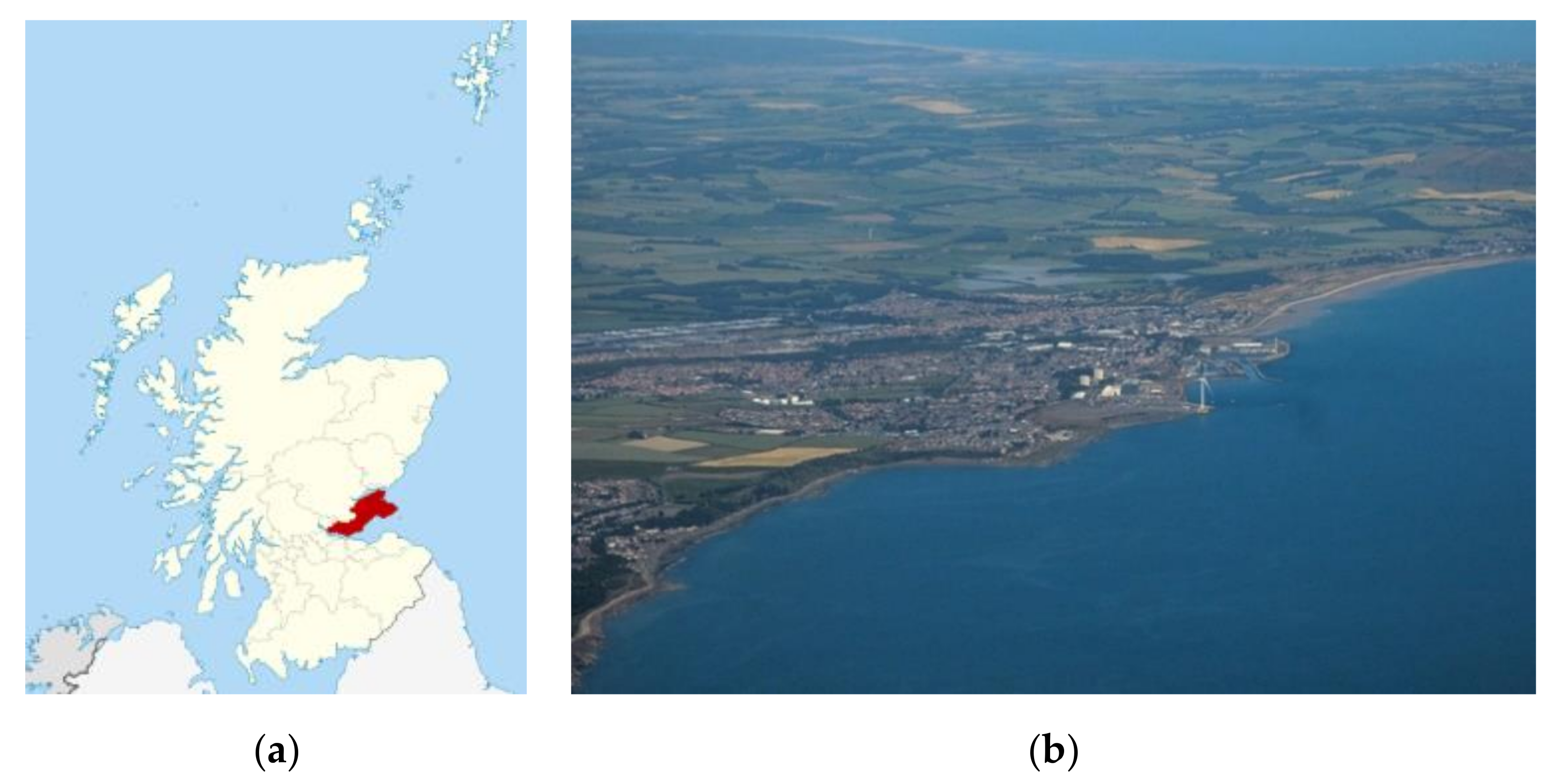
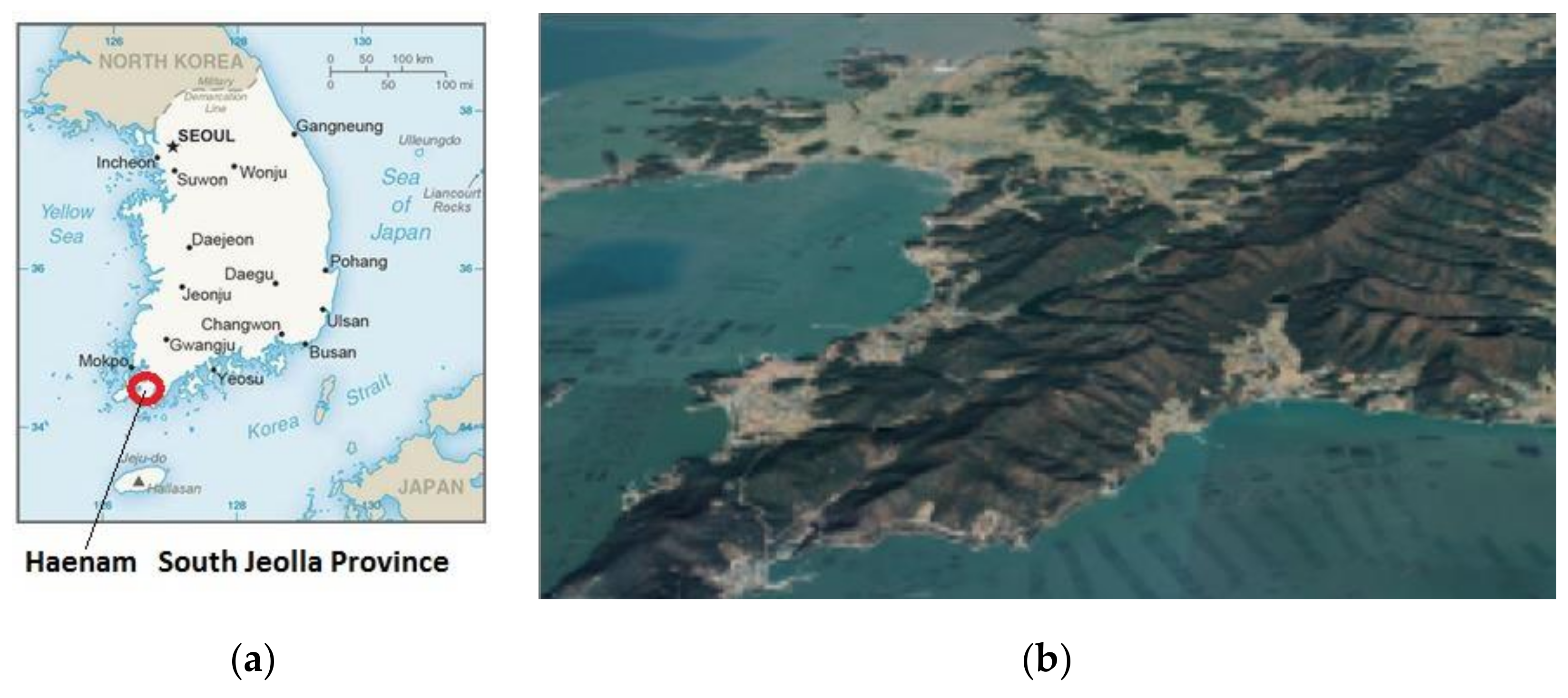
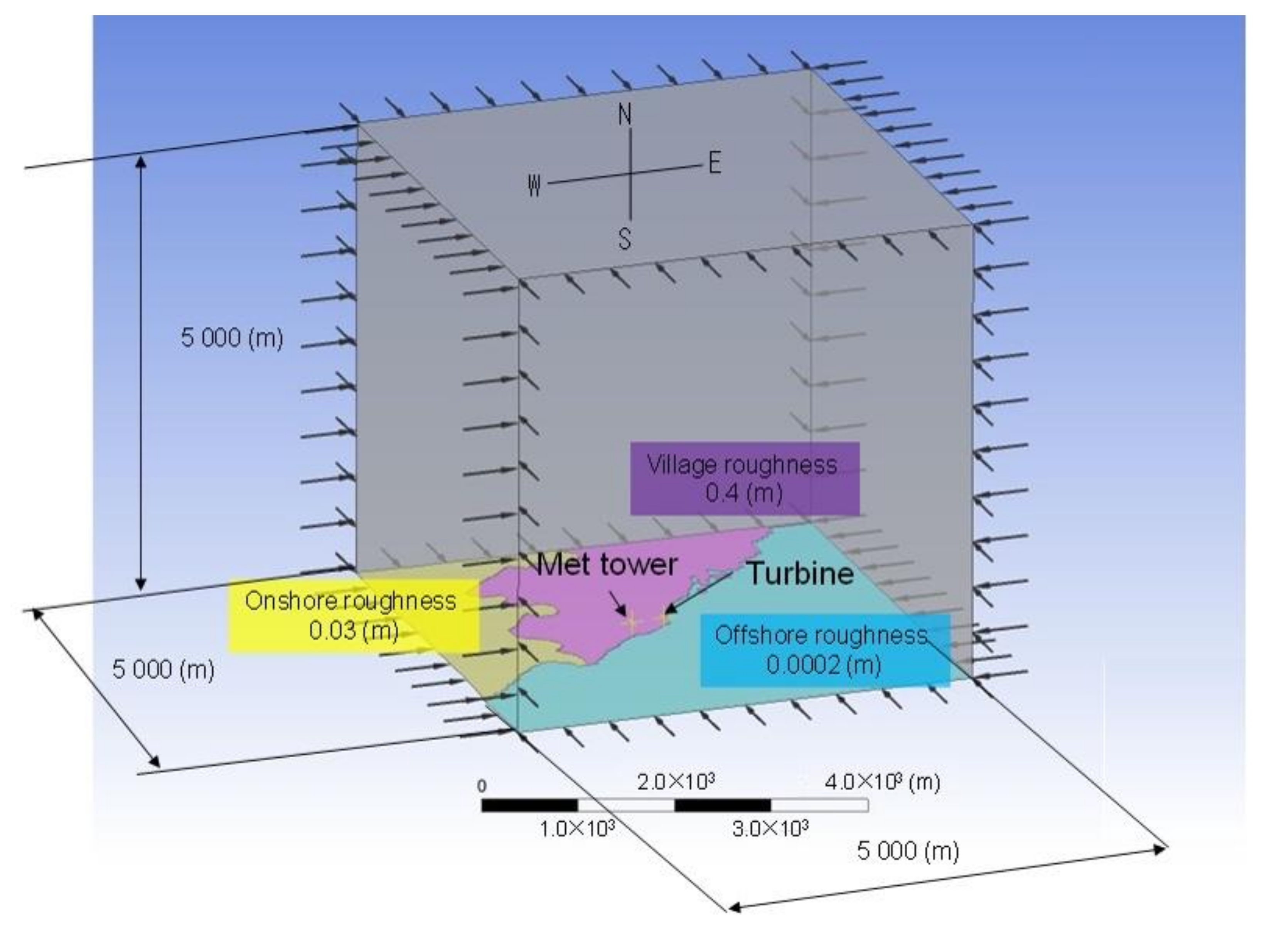



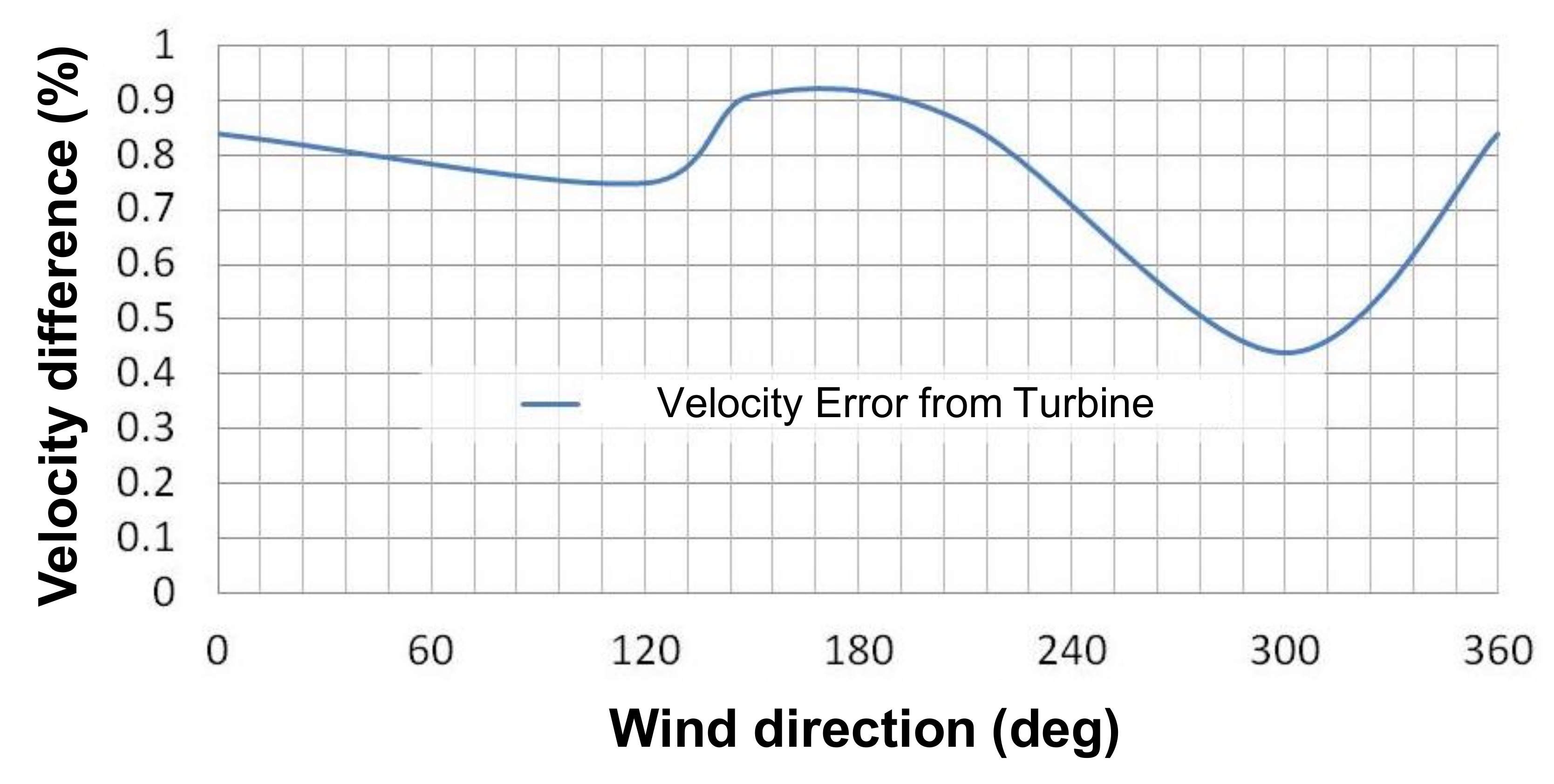
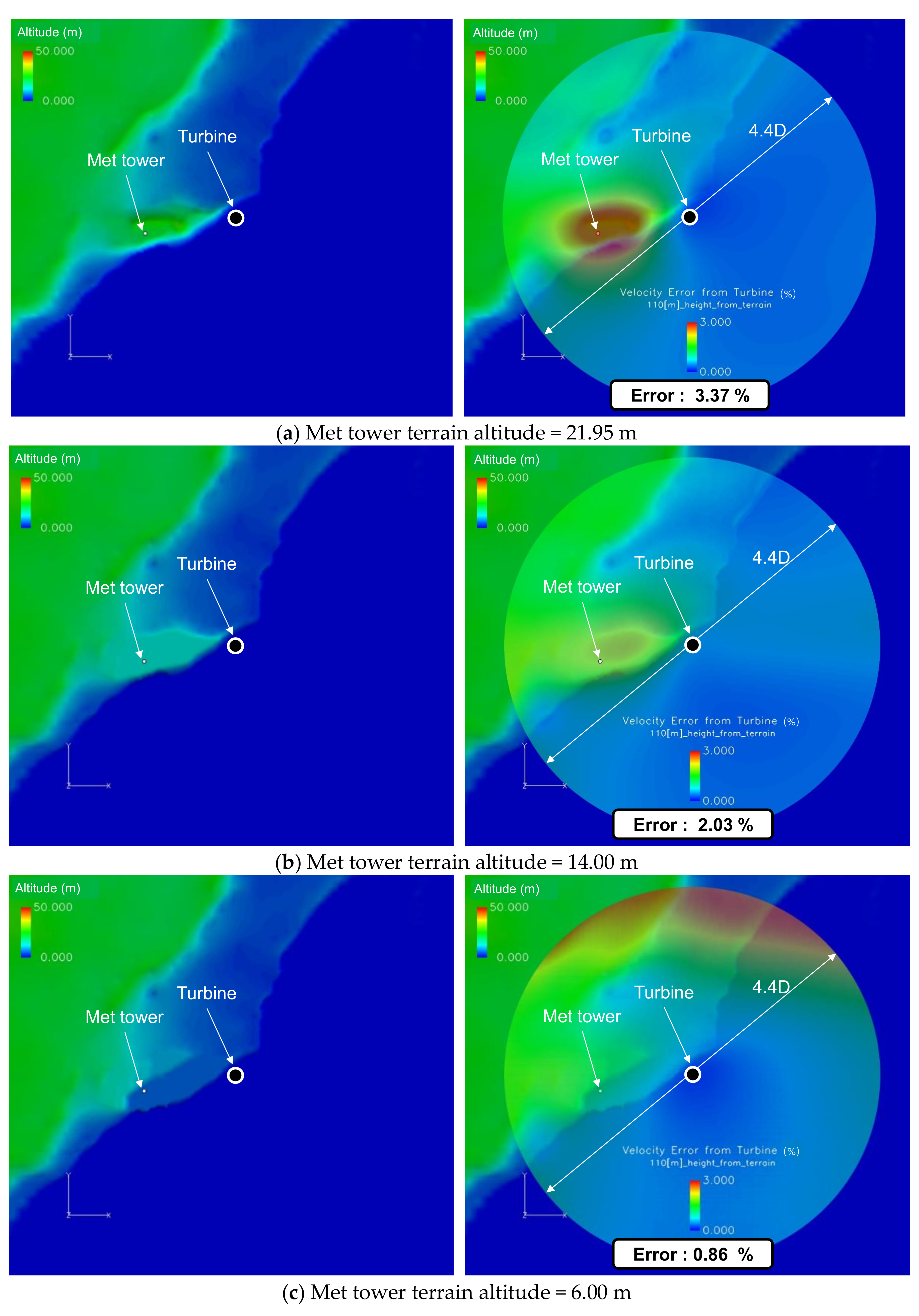

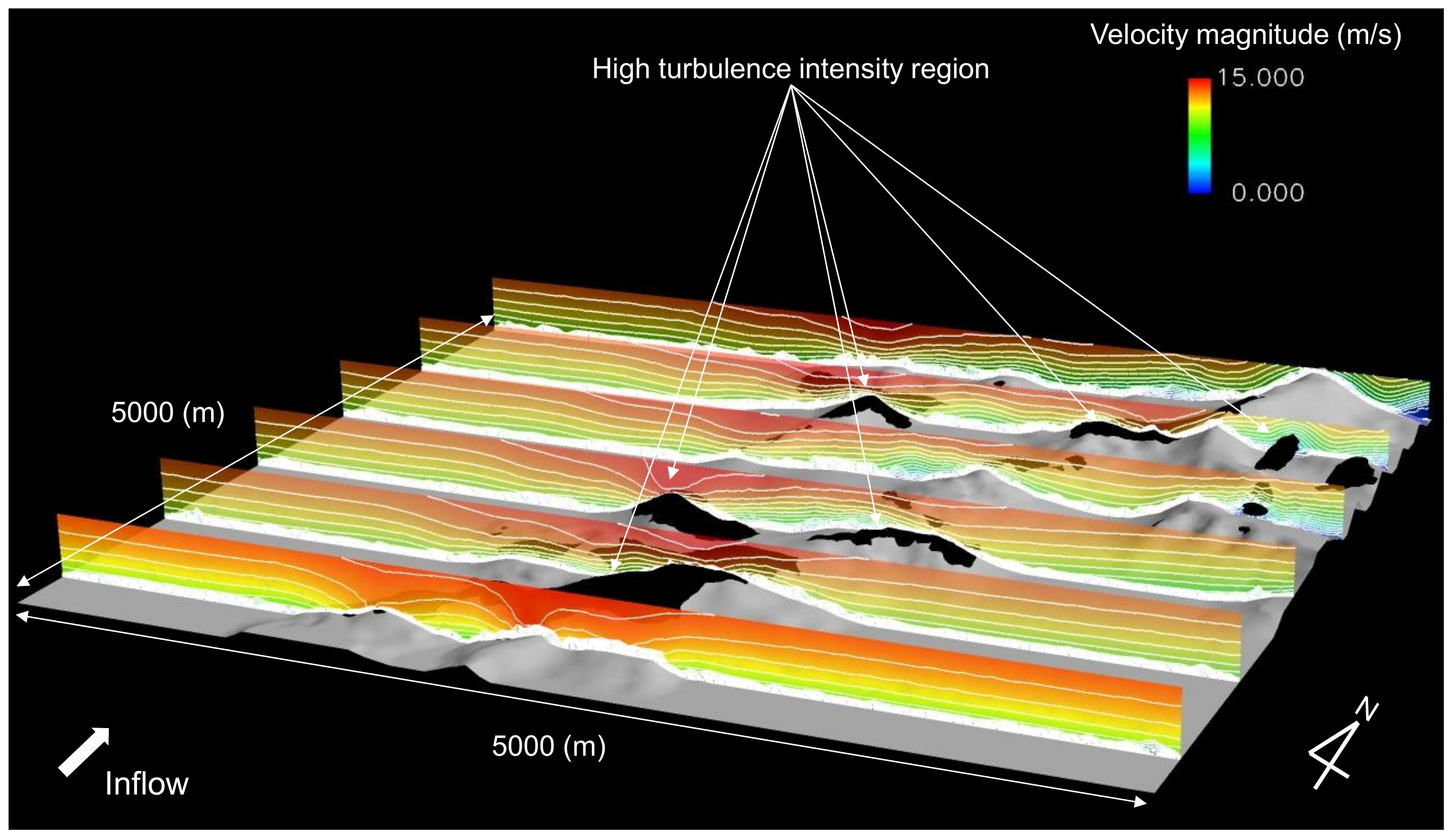

| Wind Direction (deg) | Velocity at Met Tower (m/s) |
|---|---|
| 120 | 9.82771 |
| 150 | 9.92642 |
| 210 | 10.2062 |
| 300 | 9.62557 |
| 360 | 10.1512 |
| Turbulence Model | RNG k–ε |
|---|---|
| Numerical scheme | High resolution |
| Inlet and side boundary conditions | Wind shear profile V(z) = Vhub(Z/Zhub)0.2 (Yaw error = 0 (deg)) |
| Turbulent intensity on inlet region | 5% |
| Outlet boundary condition | Pressure of 10,1300 (Pa) |
| Terrain boundary condition | No slip with each roughness value |
| Ceiling boundary condition | Free slip |
| No. | Minimum Grid Size in Each Direction | Number of Cells | Domain Size (km) |
|---|---|---|---|
| 1 | 5 m | 230 × 230 × 160 | 5.0 × 5.0 × 5.0 |
| 2 | 10 m | 170 × 170 × 120 | 5.0 × 5.0 × 5.0 |
| 3 | 15 m | 115 × 115 × 80 | 5.0 × 5.0 × 5.0 |
| Minimum Grid Size (m) | Calculated Velocity at Turbine (m/s) | Measured Velocity at Met Tower (m/s) | Difference (%) |
|---|---|---|---|
| 5 | 9.8623 | 10.2062 | 3.37 |
| 10 | 9.8684 | 10.2062 | 3.31 |
| 15 | 9.8755 | 10.2062 | 3.24 |
| Turbulence Model | Calculated Velocity at Turbine (m/s) | Measured Velocity at Met Tower (m/s) | Difference (%) |
|---|---|---|---|
| k–ε | 9.8623 | 10.2062 | 3.37 |
| SST | 9.8571 | 10.2062 | 3.42 |
| Height of Hill (m) (Wind Direction = 210 deg) | Wind Speed Difference (%) |
|---|---|
| 21.95 (original height) | 3.37 |
| 14.00 | 2.03 |
| 6.00 | 0.86 |
| Wind Direction (deg) | Velocity at Turbine (m/s) | Velocity at Met Tower (m/s) | Difference (%) |
|---|---|---|---|
| 120 | 9.75387 | 9.82771 | 0.75 |
| 150 | 9.83648 | 9.92642 | 0.91 |
| 210 (main direction) | 10.1186 | 10.2062 | 0.85 |
| 300 | 9.58328 | 9.62557 | 0.44 |
| 360 | 10.0659 | 10.1512 | 0.84 |
© 2020 by the authors. Licensee MDPI, Basel, Switzerland. This article is an open access article distributed under the terms and conditions of the Creative Commons Attribution (CC BY) license (http://creativecommons.org/licenses/by/4.0/).
Share and Cite
Jeong, J.-h.; Ha, K. Evaluation of Wind Flow Characteristics by RANS-Based Numerical Site Calibration (NSC) Method with Met-Tower Measurements and Its Application to a Complex Terrain. Energies 2020, 13, 5121. https://doi.org/10.3390/en13195121
Jeong J-h, Ha K. Evaluation of Wind Flow Characteristics by RANS-Based Numerical Site Calibration (NSC) Method with Met-Tower Measurements and Its Application to a Complex Terrain. Energies. 2020; 13(19):5121. https://doi.org/10.3390/en13195121
Chicago/Turabian StyleJeong, Jae-ho, and Kwangtae Ha. 2020. "Evaluation of Wind Flow Characteristics by RANS-Based Numerical Site Calibration (NSC) Method with Met-Tower Measurements and Its Application to a Complex Terrain" Energies 13, no. 19: 5121. https://doi.org/10.3390/en13195121
APA StyleJeong, J.-h., & Ha, K. (2020). Evaluation of Wind Flow Characteristics by RANS-Based Numerical Site Calibration (NSC) Method with Met-Tower Measurements and Its Application to a Complex Terrain. Energies, 13(19), 5121. https://doi.org/10.3390/en13195121





